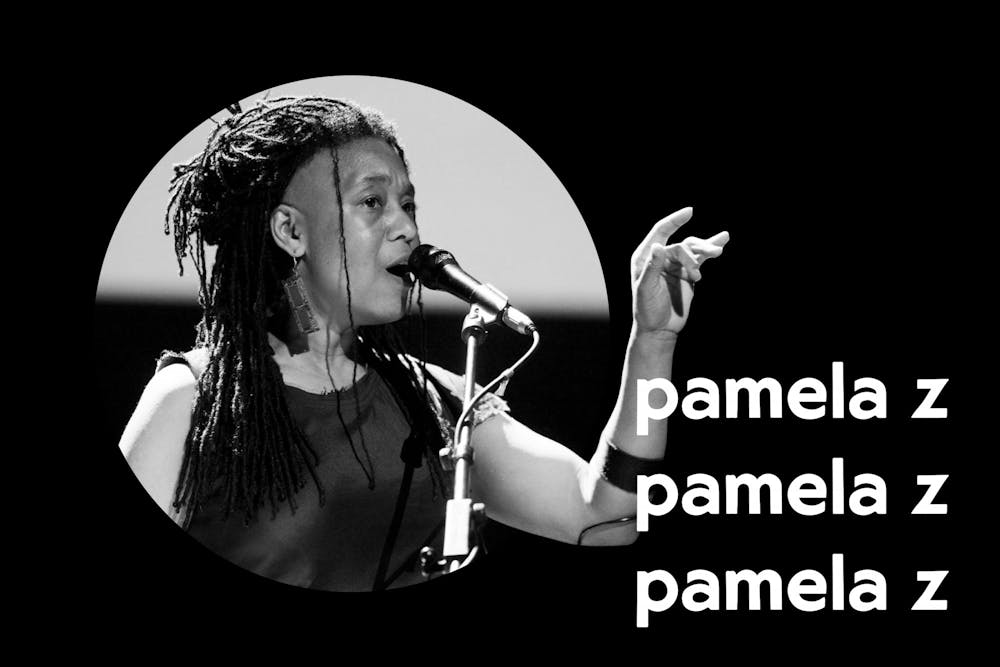Read this sentence out loud in your mind. Do you hear your speech inflections? Pitches that could be turned into a little tune? This type of enlightening perspective on sound is one of many things that Pamela Z, a composer and performer, tells us about through ambitious and experimental multimedia shows and galleries. She discussed these interdisciplinary and avant–garde forms of expression during the Music Colloquium hosted by the Penn Music Department.
Although Z focuses on voice and sound, she uses a lot more than these mediums in her music. She describes herself as a hyphenated artist: she’s a composer–performer, musician–artist, voice–and–video artist–musician, and many more. She conveys her messages—how distracting technology and notifications are, what it’s like to be a foreigner, and more—through mediums like instruments, recorded sounds, recorded interviews, video, and physical installations.
Z didn’t start off this way from the beginning. Like every artist, she went through a metamorphosis. In the beginning, her pieces were similar to pop songs and lasted four to seven minutes. But over the years, she became enamored with experimental theater and performance works, playing with longer forms to create full evening–length pieces. She's continued her artistic growth, developing more complex messages and straying farther away from relatively simple pop songs.
Today, Z's process looks something like this: Pick a very large general subject to work around and create vignettes with things like performance media, and images that hold together the audio excerpts like glue. Together, these pieces form a cohesive bundle of raw ideas that takes the audience through a trip in her brain: Think echoes, random sounds, or objects that one might see in one of those weird, twisty dreams.
For example, in a 1990s piece called “Parts of Speech,” she uses objects, projected images, and audio segments to explore languages and accents. She showed us a clip of her performance: In her signature style, she used a machine to make several voices overlap, creating a surreal and haunting effect. Z played many other recordings for us, and it was easy to see that she has so much fun with sounds, not just with her voice, her main medium, but also churning machines, trickling water, clacking typewriters, and more. It was as if Z was a kid who discovered noise for the first time.
Over the years, Z became more experimental. She started using narration at one point: a rather bold move towards interdisciplinary thinking. Z was bold in another way as well: She created utterly strange moods and feelings. One of the most memorable ones was her 2002 piece, “Gaijin,” which is the Japanese word for the concept of being a foreigner. It was creepy enough to give goosebumps—it was positively weird to see dancers in white tights prance across the stage to her strange and futuristic music.
Another piece that stood out was “Baggage Allowance” from 2010, where she explored literal and metaphorical baggage—maybe a bit of irony in there, given our situation. It was her most ambitious work at the time: It included a full evening performance work, a gallery exhibition, sound and video embedded objects, and even a recorded flash version. Z's genius really shone through here. One magic touch was that she added strange effects to audio clips of real interviews about baggage so that they would surround and annoy the audience, much like real baggage. Another interesting technique was that she repeated certain words as if to force the listener to hear the music behind it. A bland phrase became music, and in a bit of a meta moment, I realized that the voice inside my head was music, too.
Certain words commonly said, like “um,” were all played together, creating a surreal effect that potentially pokes fun at the fallacies of human speech, or simply highlights how we universally express our uncertainty. There was also an interactive museum gallery, with delightful exhibitions like a suitcase with a hologram of her curled in it or drawers on a trunk that showed different scenes on a screen depending on the drawer you opened, which I put on my post–quarantine bucket list. Perhaps it was around this time that she completely broke through the barriers between disciplines.
As the session drew to a close, Pamela Z revealed that she drew inspirations from artists all over the spectrum—this isn’t surprising, given her command of a diverse range of art fields. She is someone who sees no boundaries nor distinctions, only possibility. As a truly interdisciplinary artist who finds music and artistic worth in all corners of life, Z makes her own rules about how to show them. In the process, she stretches the definition of music and blurs the lines between disciplines, giving herself, and maybe other artists, room to express and breathe.







